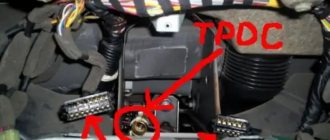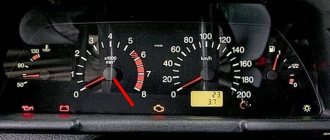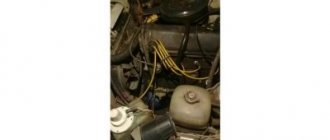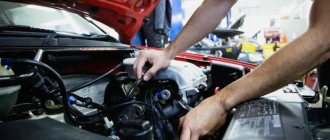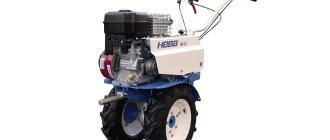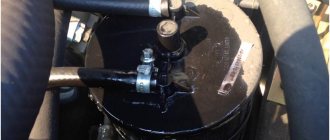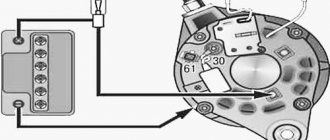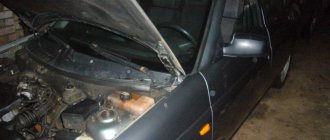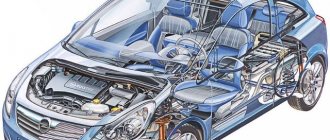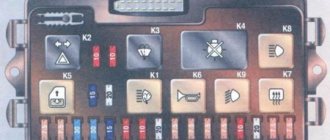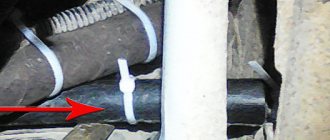Failures in the engine power system
The main fault causing the jerk is the wrong fuel mixture. Because of this, the car behaves non-standardly:
- twitches when you press the gas pedal and does not gain speed or does so very reluctantly;
- suddenly and spontaneously changes speed.
A lack of gasoline or diesel fuel in the fuel mixture does not allow the engine to develop standard power. Why does the power system fail? There are several reasons: filter, throttle assembly, fuel rail, air ducts. These units become clogged or worn out, lose their tightness or pressure. In all cases, proper diagnostics are required to find and fix the problem.
Why do novice drivers' cars jerk?
Often on city roads you can see cars equipped with a special badge with the letter “U”, which move nervously and twitchily. What is this common “disease” for beginners who are not yet used to driving? Unfortunately, this style of driving is only funny from the outside, but in a crowded parking lot it can lead to scratches and damage to other cars.
Auto experts are confident that young drivers have a somewhat inadequate perception of the environment and situation. Lacking self-confidence, the newcomer is so afraid of embarrassing others that he may stop abruptly when leaving - for example, if he sees another car that is about to do the same. In fact, among drivers there is an unspoken set of rules that govern road etiquette. When the car has already begun a legal maneuver (for example, leaving a parking lot) and has designated a trajectory, everyone else calmly waits for its completion and then drives themselves. If everyone “gallantly” gives way to the other, real confusion will arise.
The second reason is related to the fear of suddenly stalling, which causes novice drivers to press the pedals hard and sharply. In fact, a stalling engine does not mean anything terrible, you just need to be able to get out of the situation correctly. The algorithm is as follows:
– release the clutch until slight vibration appears;
– when vibration occurs, the vehicle begins to roll;
– you need to stop your foot on the clutch pedal;
– lightly touch the gas pedal;
– release the clutch completely.
However, you should not use this guide in all situations - it is more suitable for starting at a traffic light, since it allows you to immediately join the traffic flow at an average speed. In parking lots and in tight, narrow courtyards, you will need to be able to maintain a speed of about 1 km/h. For this:
– release the clutch until slight vibration appears;
– when vibration occurs, the vehicle begins to roll;
– if you press the clutch all the way, the car will start to stop by inertia.
It is important to be able to use this feature correctly. If you need to increase the speed a little, the clutch is released a little again, the car rolls, and if you need to stop, the pedal is pressed to the floor.
You can learn how to use the clutch pedal correctly and effectively through driving courses or from a private instructor. The latter option is even more preferable, since the mentor will have the opportunity to devote time to only one student and focus on those points that are less well developed. Can driving instructors offer theirs inexpensively?[/anchor] Our capital is a big city, so the number of offers here is really large. However, experts advise first of all to pay attention to driving experience, as well as teaching experience, which is the key to successful work with a student.
| Tweet |
Incorrect operation of the ignition system
The ignition system also causes unstable engine behavior due to:
- spark plugs - the fault is easily determined by the color of the deposit and the size of the contact gap;
- high-voltage wires - it is recommended to check with a megger;
- coils - visually inspected for cracks and current leakage.
It is advisable to check spark plugs with a special spark plug. It will allow you to correctly determine the gap between the electrodes, which is normally 1-1.3 mm (on carburetor cars - 0.7-0.8 mm). Increasing this value leads to damage to various ignition system devices. Any known-good spark plugs are also used as a tester.
The coil is also checked for spark. Diagnostics will require a spark plug wrench and pliers. During the test, the ignition must be turned off. Then any armored wire is removed and connected to a known working free spark plug. Next, the engine is started and the spark that appears between the electrodes of the spark plug is examined. Its color should be bright purple.
Poor engine performance is often caused by a short circuit or open circuit in the low voltage circuit. Incorrect connection of the wires to the spark plugs also significantly reduces the performance of the internal combustion engine, causing interruptions.
Problems in the ignition system
The engine may also run unstably and jerk while driving if there is a problem with the ignition system. In addition to jerking, there is a loss of power, increased consumption, etc.
An independent test involves diagnosing power wires, spark plugs, ignition coils, and DPRV. To detect a possible cause, it is necessary to turn off the ignition, after which the reliability of fastening the high-voltage wires to the coil and spark plugs is checked. Next, the engine starts and its operation is assessed by ear. Special attention should be paid to the peculiar “crackling” sounds that can occur as a result of a spark breaking through in some area.
Such deposits are removed mechanically using a stiff brush. If the car does not stop jerking after cleaning or replacing the spark plugs, then it would be a good idea to check the camshaft position sensor with a multimeter.
Transmission breakdowns
Engine malfunction may be due to damage to the transmission. Most often, the clutch wears out or the grenades break. Less often, the gearbox and its mounting components, including the supports and brackets of the power unit, fail.
The most difficult thing to determine is the failure of the gearbox and clutch - they have to be dismantled and disassembled. It is much easier to diagnose the condition of the airbags and CV joints by using a lift or inspection hole. To check their mobility, the hinges are pumped in different directions. Breaks in motor supports are detected as follows: take a long crowbar and lift the motor (box) near the attachment points. Damage is immediately noticeable.
Why does the car jerk when accelerating?
All passenger cars with gasoline engines in use today are equipped with either injection or carburetor power units. The second type of internal combustion engine is now considered almost “rare”, but in Russia (especially in the provinces) there is still quite a lot of such equipment “on the move”. Therefore, considering the possible reasons why passenger cars can jerk and accelerate jerkily, it makes sense to start with them.
Carburetor engines
These power units, compared to more modern, injection ones, are simpler in design, all their “weak points” have been well studied, and therefore it is not so difficult to find the reason for their unstable operation at the stage of starting and accelerating the car.
Experienced motor specialists with knowledge of the matter claim that cars with carburetor engines most often jerk due to problems such as: Thus, those owners of cars with carburetor engines whose cars began to jerk when starting the engine and accelerating should, first of all, , check exactly those parts, components and assemblies that are listed above.
If it turns out that everything is in order with them, then you need to pay close attention to the ignition system. In carburetor engines, its malfunctions are also often the cause of jerking. Practice shows that in cases where, when you press the accelerator pedal, the car refuses to accelerate (as drivers say in their professional slang, it “fails”), it makes sense to thoroughly check the ignition coil, as well as the high-voltage wires connected to it.
In fact, it often turns out that these parts begin to “punch through”, and therefore the engine “troubles”. The solution to the problem in this case is to replace the faulty part.
Another fairly common problem is banal carbon deposits in candles. It leads to the fact that the spark does not occur when it should (and sometimes does not occur at all), which leads to jerks during acceleration. The way out of this situation is to clean or replace the spark plugs.
Injection engines
Gasoline power units of this type have significantly better operational and technical characteristics than carburetor units, but their design is much more complex.
Accordingly, there are much more reasons why a car may jerk during acceleration. The main feature of an injection engine is that a special electronic unit regulates the flow of the fuel mixture into its combustion chambers. Several sensors are involved in this process, namely:
A malfunction of any of them may cause the car to jerk when starting the engine and accelerating. It is interesting that if serious problems arise with the crankshaft position sensor, the injection system is often turned off completely, and then it is impossible to start the engine at all.
It goes without saying that the reasons for jerking during acceleration of cars equipped with injection engines can be the same as for carburetor engines, that is, clogged filters, problems with spark plugs, ignition coils and high-voltage wires, as well as fuel system elements (including and clogged fuel injectors).
It should also be noted that one of the common reasons for a car to jerk when starting the engine and accelerating is the use of low-quality fuel. As a result, a lean fuel mixture is formed, and the engine begins to operate very unstable, in particular, jerks appear during acceleration. This applies equally to both carburetor and injection power units.
Bad fuel
Today, fuel is spoiled not only by water, but also by various unknown additives. This fuel contains a lot of sulfur, benzene, aromatic hydrocarbons and ethers. Therefore, all vehicle systems are subject to increased loads. First of all, the injector, ignition, and exhaust suffer. Then, due to increased detonation, the engine overheats - the pistons, rings, and cylinder walls are damaged.
If you have already poured a low-quality composition, get rid of it immediately! Empty the tank, flush the fuel system, clean the injectors and replace the spark plugs. Only after these steps, refuel with good fuel.
Clogged air and fuel filters
On cars of recent years of production, several fuel filters are used. Their main task is to capture large and small deposits and impurities - the power system and internal combustion engine do not tolerate dirty fuel well. There are fine and coarse cleaning elements - the latter are a mesh and are located inside the fuel pump. The filter life is limited - they last 15-30 thousand kilometers. The mesh can last up to 100 thousand km. The main sign of blockage is jerking and jerking of the vehicle. At the same time, other disadvantages arise:
- fuel consumption increases;
- The power of the power unit decreases - acceleration deteriorates;
- The motor stops spontaneously at idle or while moving.
A dirty fuel filter is replaced, or less often cleaned.
Almost the same thing happens with a dirty air filter. The car jerks even more intensely, and engine detonation increases. Then the spark plugs fail, and all the electrics begin to “go crazy”, showing various warnings such as Check Engine on the display. A new filter costs about 200-300 rubles, so it is advisable to replace it frequently - every 10 thousand kilometers.
Clogged or faulty injectors
During prolonged operation of an injection engine, varnish and resinous deposits from fine particles and heavy fractions of sulfur, hydrocarbons, and ethylene accumulate on the injectors. They greatly slow down the operation of the injection system, change the direction and shape of the spray, and in some cases completely shut off the fuel supply. Obviously, in such a situation, the formation of fuel worsens, the tightness of the regulators is broken, and the overall performance of the internal combustion engine decreases. Therefore, the car moves jerkily and twitches.
Replacing injectors according to manufacturers' recommendations should be done every 120-150 thousand kilometers. But it’s much more important and important to clean them. This must be done at least after 30,000 miles, especially on Russian roads.
Popular brands:
Kia Sportage
Other reasons
Engine malfunctions are also caused by other factors:
- problem of the idle speed sensor - contamination, damage or combustion of the winding;
- dysfunction of the fuel tank - often in the summer a vacuum forms inside the tank due to a tightly fitting neck cap, the pump is not able to pump out fuel normally;
- damage to the fuel pump - you can check the operation of the unit without removing it, just evaluate how the mechanism pumps manually;
- wear of the distributor - it should be dry under its cover, be sure to also check the operation of the vacuum and centrifugal regulator;
- incorrect setting of ignition timing;
- incorrect operation of the processor - electronic control.
Remember that failures are also caused by the engine itself - breakage of oil scraper rings, burnout of pistons, scuffing of cylinders. It is possible to accurately determine the “culprit” only after a detailed inspection of the machine components.
It is better to entrust diagnostics to specialized car services, as they do in Moscow, St. Petersburg, Novosibirsk and other cities. For example, on BMW models, a drop in engine power is possible due to the VANOS sensor, and on Mercedes-Benz and some other foreign cars - due to a “glitch” in the program responsible for integrating the engine with the gearbox. This can be checked correctly only with professional instruments.
Checking for faults in the car's fuel system
The purpose of the fuel system is to store and supply fuel to the combustion chambers. It consists of the following components:
- gas tank, container for storing gasoline or diesel fuel;
- fuel pump, its task is to move fuel from the tank to the engine;
- fuel level sensor, monitors refueling;
- a fuel filter system that performs the task of cleaning fuel from “garbage”;
- an air filter is needed to clean the air for preparing a combustible mixture;
- fuel lines are designed to deliver fuel to the mixture formation device;
- carburetor, injector - devices where mixture formation occurs (fuel + air);
- The injection system is responsible for supplying the air-fuel mixture to the combustion chamber.
Consequently, if a malfunction occurs in one of the system components, then the motor malfunctions. And as a result, the car jerks. First, you should check the fuel filter and pump.
Secondly, it is worth paying attention to the condition of the injectors. Then diagnose the sensors: mass air flow, throttle valve, idle speed. Of course, the air ducts cannot be ignored; they must be checked for leaks. Malfunctions in the injection system occur if dirt gets into the fuel supply system or the contact in the electrical network is lost.
